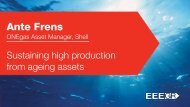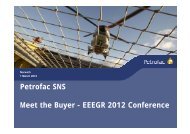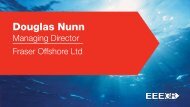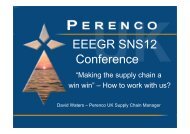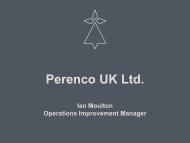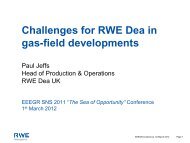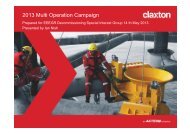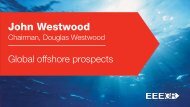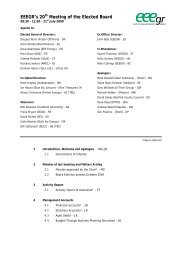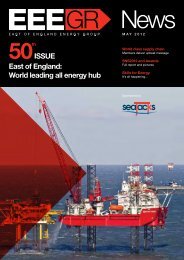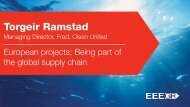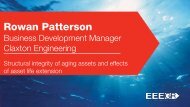Download PDF - EEEGR
Download PDF - EEEGR
Download PDF - EEEGR
You also want an ePaper? Increase the reach of your titles
YUMPU automatically turns print PDFs into web optimized ePapers that Google loves.
HEALTH & SAFETY<br />
Safer than houses!<br />
C Simon Gray, <strong>EEEGR</strong> chief executive<br />
It would be obvious to say that three top priorities<br />
for the energy sector are - safety, safety<br />
and safety.<br />
AREVA's Andrew Fox put it as simply at<br />
the <strong>EEEGR</strong> 2012 Conference when he said<br />
supply chain businesses were assessed on<br />
quality, cost, delivery and safety. “But safety<br />
is everything.”<br />
Health is inextricably linked with safety.<br />
Unhealthy, unfit personnel can make dangerous<br />
mistakes or decisions. Lack of attention to<br />
safety can lead to catastrophe.<br />
Our high risk energy sector has a remarkable<br />
record for safety. But that is not enough.<br />
We must always strive to improve.<br />
That's why this issue has a special focus<br />
on H&S; the many companies involved in a<br />
whole range of aspects - the new initiatives,<br />
the training, the protection, the supervision<br />
and the equipment.<br />
It forms a critical element to our supply<br />
chain and one, without which, our industry<br />
could not operate.<br />
Oilennium revitalises<br />
Seajacks’ training<br />
C Samantha O’Hara, Oilennium<br />
C 01508 522 700<br />
C sam@oilennium.co.uk<br />
C www.oilennium.com<br />
Oilennium Ltd has successfully completed<br />
a series of customised eLearning training<br />
programmes for Seajacks, the Great<br />
Yarmouth-based operator of purpose-built,<br />
self-propelled jack-up vessels.<br />
Initially, Seajacks asked Oilennium to<br />
provide effective, cost-effective training for its<br />
employees.<br />
The first requirement was to help enhance<br />
the company’s health and safety training<br />
programme and the primary objective was to<br />
revitalise Seajacks’ existing programme by<br />
offering a more dynamic, interactive training<br />
experience.<br />
To achieve that, Oilennium provided<br />
Seajacks with access to a wide range of<br />
health and safety courses through its Learning<br />
Management System (LMS), an online<br />
user-friendly system that features interactive<br />
training tools.<br />
These courses, currently being taken<br />
by 150 employees around the world, provide<br />
training in confined space entry, task-based<br />
risk assessment, COSHH, manual handling,<br />
lifting operations, and noise awareness.<br />
Bespoke programmes were devised<br />
for Seajacks featuring lively animations and<br />
meaningful graphics that provide delegates<br />
with a clearer, more immediate understanding<br />
of the subject matter.<br />
Delegates demonstrate what they’ve<br />
learned through a series of knowledge checks<br />
and a final exam.<br />
“The health and safety courses proved<br />
to be so popular and effective, we decided<br />
to bring Oilennium in to revitalise our vessel<br />
induction video for the harsh environment<br />
installation vessel Seajacks Kraken,” said<br />
Max Paterson, sales and marketing manager<br />
for Seajacks.<br />
“Their work on the Kraken vessel video<br />
was so impressive, we decided to have<br />
Oilennium develop bespoke videos for two<br />
more vessels: the Seajacks Leviathan and the<br />
Seajacks Zaratan. Since we began training<br />
our employees via the new safety training and<br />
vessel induction programmes, there has been<br />
a marked improvement in employee appreciation<br />
of safety, and of the unique characteristics<br />
of each vessel.”<br />
Kevin Keable, managing director of<br />
Norfolk-based Oilennium, added: “Developing<br />
a culture that is vigilant and truly dedicated<br />
to best practices in HSE requires hard work,<br />
dedication and sheer persistence”.<br />
Above: Seajacks retained Oilennium to revitalise its<br />
vessel induction video for the harsh environment<br />
installation vessel Seajacks Kraken.<br />
New focus as<br />
windpower reaches<br />
deeper waters<br />
C 020 7851 5311<br />
C www.thecrownestate.co.uk<br />
As the offshore wind industry moves truly<br />
‘offshore’ into deeper waters - now similar to<br />
the southern sector oil & gas developments -<br />
the focus on health & safety has dramatically<br />
intensified to ensure that projects can be<br />
delivered safely.<br />
The Crown Estate’s health and safety<br />
champion Peter Hodgetts said: “Now, after<br />
more than 12 years of offshore wind, we are<br />
continuing to learn vital lessons even as we<br />
move further offshore. Deeper water creates<br />
changes in our risk profile but we can learn<br />
from other sectors, including oil & gas.<br />
“The Crown Estate is championing many<br />
of these initiatives with a range of strategic<br />
workstreams which reflect areas that concern<br />
our development partners. We also<br />
reward good practice through our Health &<br />
Safety Award.”<br />
A unique element of the offshore wind<br />
sector is the very large number of vessels<br />
utilised throughout the lifecycle, numbering<br />
up to 35 or 40 vessels on site during the<br />
construction phase, requiring rigorous marine<br />
co-ordination.<br />
Recently published by The Crown Estate<br />
was a Vessel Safety Guideline designed to<br />
support developers in selecting vessels ‘fit<br />
for purpose’ through the development phase<br />
and a further guideline is planned to address<br />
vessels that will be used during the<br />
construction phase.<br />
Its Safer by Design workshops brought<br />
together a large cross-section of industry<br />
experts to discuss lessons learned as well as<br />
looking ahead at the factors that will influence<br />
the whole lifecycle of projects.<br />
“An important step is that the industry<br />
is now moving from a ‘day trip’ scenario to<br />
a format similar to the oil & gas sector with<br />
personnel living offshore for extended periods<br />
and this brings another range of factors that<br />
must be managed and the industry is rolling<br />
out the first offshore wind training courses,”<br />
said Mr Hodgetts.<br />
NOVEMBER 2012 – 03



